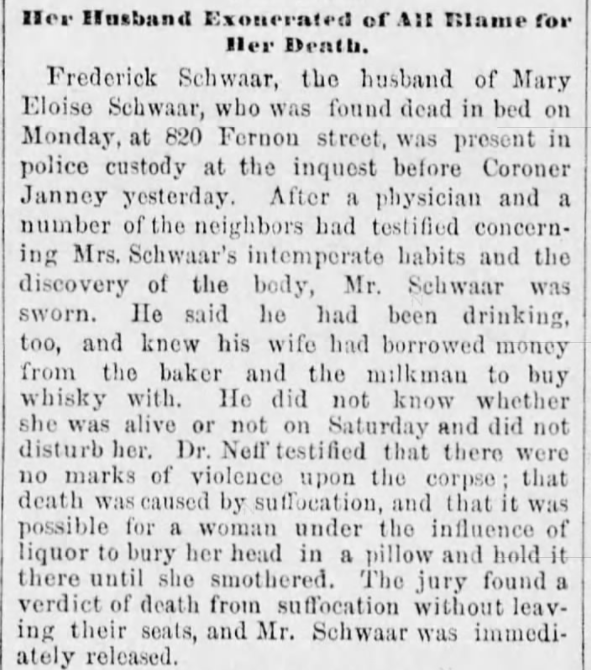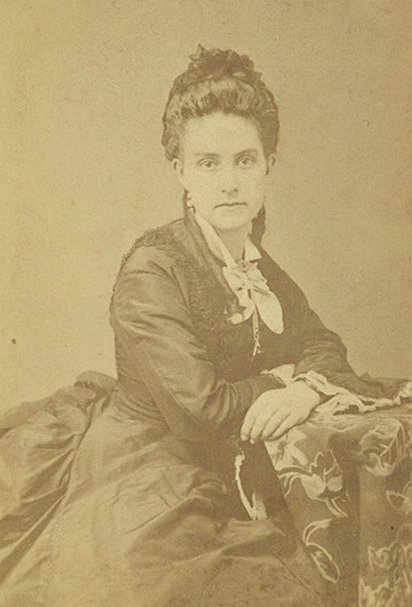While researching my maternal grandfather’s ancestry line, I came across a branch that came to the United States via Canada; the Rodier family. My second great-grandmother, Albina Rodier, was born in 1848 in Canada and some time after 1852, the family immigrated to New Jersey. Her youngest sister, Mary Eloise Rodier, was twenty when she married a Swiss immigrant named Ferdinand Schwaar in Manhattan. 9 years and one son later, they were living in south Philadelphia and Mary was found “partially decomposed” in her home after her neighbors failed to see her for three days. Her death was almost exactly 141 years ago from today.
According to the multiple newspaper articles, Mary was an alcoholic who neglected her husband and son; rarely cooking for them, which was obviously the worst thing a female could do in the 1800s. The articles mention that when she as sober she “showed contrition” about her condition, but the majority of the stories paint her as a generally awful person. One article mentions her husband “only drank on Sundays” but then in the next paragraph reports he was seen the Saturday during which she was missing as appearing intoxicated.
Ah, the life of a man. Just like his wife, he drinks more than one day a week, but as long as he isn’t “not cooking” then he’s doing totally fine, thank you very much.
Ferdinand is listed in census records as a jeweler and in newspaper stories he is said to be a watch maker or watch case maker. It’s unclear when he immigrated to the United States or what his life was like back in Switzerland, but as of this post, I haven’t found him in a census record before 1880, so its possible and very likely that he came after 1870 and married Mary soon after arriving.
Based on an interwebs search, their home was in extremely close proximity of their goddamn nosy neighbors:

The timeline of Mary going missing to being found seems to be:
Thursday, January 27, 1881: Neighbors reportedly saw Mary that evening when she had “visitors” to the home, although who the visitors were was never mentioned. It was reported that the “alcohol flowed freely” (did these neighbors have binoculars or her home bugged?), but they never heard any fights, screams, or falls.
Friday, January 28, 1881: Nothing. No mention of her, Ferdinand, or their 7 year old son, George.
Saturday, January 29, 1881: Ferdinand Schwaar is seen leaving the home in a “partially intoxicated condition.” A girl named Sarah, who reportedly helped around the house, came over and saw Mary “asleep” in a bed that was in the front room of the house. Mary had all of her clothes on (not pajamas) and apparently had no interaction with Sarah during this time period. There is also no mention of where George is during this time.
Sunday, January 30, 1881: Ferdinand is seen coming home (where the fuck was he all night?). Once again, Sarah is at the house and sees Mary in the same place and condition that she was the day before. Kinda feel like at this point something wouldn’t exactly smell right in the house? On this Sunday morning, a neighbor reportedly made breakfast for George, making me wonder if he was home the entire time with his dead mother while his dad was disappeared all night.
Monday, January 31, 1881: George tells a neighbor that his mother “wouldn’t get up.” Whoever he told went to Sarah, who then went back over to the house. Sarah found Ferdinand on a “lounge in the kitchen” and he “seemed to be getting over a spree” which I guess is 1880s code for either hungover or still drunk from Sunday (or Saturday)? Sarah (rightfully) fled the house and went to get a proper adult to come deal with these shennanigans. The next door neighbor came back with her and found Mary still in bed, still wearing the clothes she was seen in by Sarah and was completely cold to the touch. She was lying face down on the bed, covered by a shawl, and there was coagulated blood on the pillow that came from her mouth and nose. Her throat had marks on it and her face was swollen and discolored (probably due to decomposition setting in for several days). The coroner who later examined the body said she had been dead for at least two days.
Ferdinand Schwaar had several differing statements during this time period. Obviously when Mary was discovered he was either drunk or coming off of a binge and not in his right mind. But he made statements that she was fine the day before because he gave her tea. He claimed she was only asleep. At the police station, he insisted that she had broken into her son’s piggy bank and stolen money for liquor on Saturday and that Sunday he offered her tea and she refused it.
The next day, this was posted:

First of all, what in the hell does her borrowing money have to do with this story? He knew she borrowed money but didn’t notice she clearly hadn’t moved in several days? No one asks him why he wasn’t home from Saturday to Sunday?
Secondly, in all the times in my life I’ve ever gotten drunk or had friends who drank, none of us “buried our heads in a pillow and held it there until we smothered.”
That sentence alone makes me so incredibly angry. Even if she was an alcoholic, she didn’t deserve to be murdered.
Obviously, the people involved in this inquiry or autopsy held no regard for this woman because she was an addict. They took neighborhood gossip and the husband’s word over what scientifically seems pretty crystal clear. Even if Mary had decided to end it all and held herself (facedown) into a pillow, it would only cause her to pass out, at which time her muscles would relax and human instinct would take over. She was reportedly wearing a lace shawl and I’m not sure how someone would go about smothering in lace. Somehow, Mary was forced into the pillow so long that blood came out of her mouth and nose, but she had no marks on her? But she did have marks on her throat the day before? One news article explained, “The blood had flowed profusely from her mouth and her discolored face was smeared with it.”
Huh. So she held her head in one place long enough to kill herself, but somehow after she did it long enough to get some blood out, she smeared it around. After she was dead.
OR MAYBE SHE WAS STRUGGLING?
Regardless, Ferdinand Schwaar was never charged with any crime. The 1890 census has been lost in time to a fucking fire in the 1920s, so not sure what happened in the years shortly following Mary’s untimely death.
According to her death certificate, Mary was buried in Philanthropic Cemetery in Philadelphia. The cemetery closed in 1914 and all of the bodies were relocated to nearby Arlington Cemetery, but in a search of their records, I was unable to find where she is specifically located. It seems like once again, she became a victim of Pennsylvania politics.
Ferdinand remarried almost exactly 2 years later on February 6, 1883 to a French woman who had immigrated to America in 1881 named Marie. I’m guessing she missed all the newspaper articles about the previous wife? They had three daughters before Ferdinand died himself at the age of 43 with no mention of pillow involvement.
George apparently got married in the 1890s, but by 1915, his wife was listed as widowed, though I’ve been unable to find any records of his death. If he did pass away by then, he would have also died tragically young.
I’ve never found a picture of any of them, I doubt any would exist any more if they’re not in my giant tupperwares full of family ancestry, but here is my 2nd great-grandmother, Albina Rodier. I like to think Mary looked a lot like her.

